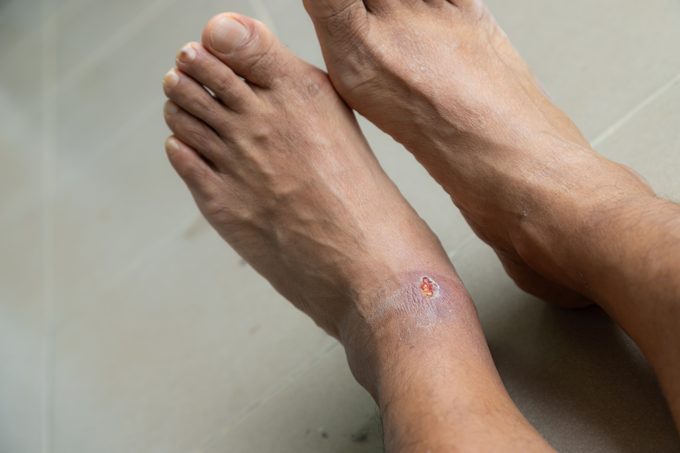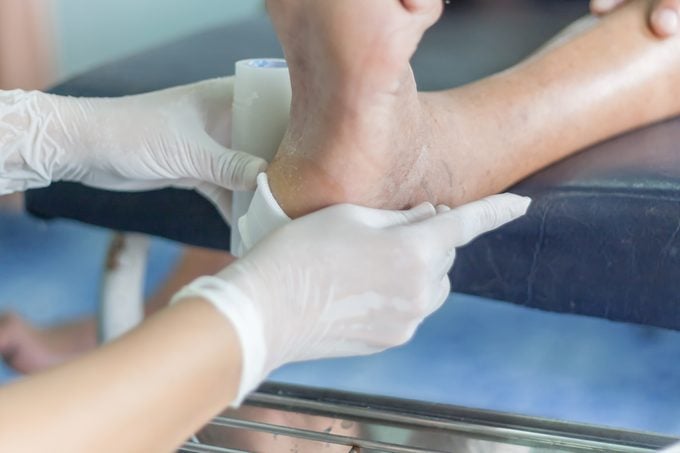How Diabetic Foot Ulcers Start (and How to Prevent Them)
Updated: Oct. 08, 2020
Diabetic foot ulcers are an outward symptom of diabetes that affect millions of Americans and can cause big-time problems if left unchecked. Here's what you should know about diabetic foot ulcer symptoms, prevention, and treatments.
Just over one in every ten Americans (or 34.2 million people) have diabetes and another 88 million adults have prediabetes. While many of the health risks that come with a diagnosis are happening inside the body, diabetic foot ulcers are one outward symptom of diabetes that can be painful and debilitating if not treated.
Here are some important things you need to know about the symptoms, treatments, and ways to prevent this diabetic foot problem.
What are diabetic foot ulcers?
“Diabetic foot ulcers are open wounds that penetrate through both the epidermis (the surface layer of skin) and the dermis (the deeper layer that separates the outer skin from the tissue) in patients with diabetes,” explains podiatric surgeon Rebecca Pruthi, DPM, owner of Foot Care of Manhattan in New York City.
Typically beginning as a small callus or blister, these sores are most commonly found on the bottoms of the feet but can also occur on the legs and hands. Repeated rubbing on the callus causes bleeding under the skin, explains Aaron Chidakel, MD, an endocrinologist with the Diabetic Foot and Ankle Center at NYU Langone Health.
“This bleeding then erodes the skin, leading to ulcer formation.”

Risk factors for diabetic foot ulcers
“Diabetic foot ulcers are quite common. In fact, they are responsible for more hospital admissions than any other diabetic complication,” says Dr. Chidakel. According to the American Podiatric Medical Association, about 15 percent of people with diabetes (that’s 5.13 million Americans) will develop a foot ulcer.
People with diabetes who are over 45, overweight, have smoked cigarettes, or have compromised circulation are at the highest risk, as are Latinos, Blacks, and Native Americans in the U.S.
Foot ulcers are one of the most common causes of osteomyelitis, or a bone infection, in the foot, which can require amputation in order to keep the infection from spreading throughout the body. According to research in the journal Diabetes Care, 115,000 adults with diabetes required an amputation in 2015, and a diabetic foot ulcer was the reason behind 85 percent of them. But if you know the causes and treatment options for diabetic foot ulcers, amputations can be avoidable.
Causes of diabetic foot ulcers
There are a number of diabetes symptoms and problems that contribute to the development of foot ulcers. One is poor glycemic control, or high blood sugar, which can damage the nerves that extend into the extremities. This nerve damage is called peripheral neuropathy.
“This leads to loss of feeling in the legs and feet, allowing sores to develop undetected,” explains Dr. Pruthi. This loss of sensation means you may not feel a pebble in your shoe or an uncomfortable seam in a sock until it’s too late. Because of circulation problems and poor wound healing, a tiny splinter, a carelessly clipped toe nail, or a blister can get progressively worse. There’s no such thing as a minor foot injury if you have diabetes. Here’s a list of recommended shoes for women with diabetes.
“People with diabetes also develop severe atherosclerosis of the small blood vessels in the legs and feet,” says Dr. Chidakel. This clogging of the arteries restricts blood flow to these areas, allowing wounds to grow unchecked. “Because blood is not able to reach the wound, healing is delayed, which can eventually lead to necrosis and gangrene,” Dr. Chidakel adds.
Nerve damage can also dry out the skin on the bottoms of the feet, making it more likely that the sore will progress into an open wound.

Treatments
“If they are identified early and you start treatment right away, the prognosis for these ulcers is good,” says Dr. Chidakel. “The best treatment depends on the stage of ulcer formation.” If an infection has developed in the ulcer, antibiotics can be used to get rid of it. Then once the wound is clean and free of infection, doctors may perform debridement, or the removal of all calluses, infected or dead tissue and any foreign debris that has made its way into the ulcer.
“Keeping the foot clean and dry and removing pressure are key,” notes Dr. Pruthi. That means cleaning your ulcer daily per your doctor’s advice, keeping it covered with a clean bandage and dressing, and using special shoes, braces, or crutches to stay off the area. “Managing the patient’s blood sugar and diet will help too,” she adds. Keeping blood sugar under control can help improve circulation issues and reestablish blood flow to the wound, helping it heal faster. (Here’s a firsthand account of what it’s like to have diabetic foot problems.)
“For non-healing wounds, assisted closure can be undertaken as well,” says Dr. Chidakel. This procedure, also known as VAC (vacuum-assisted closure), uses a device to decrease air pressure around a wound, which pulls fluid from the wound, reduces swelling, pulls the edges of the wound together, and stimulates the growth of new tissue to help it close. In a 2019 randomized controlled trial from India, VAC was found to speed ulcer healing and reduce pain.
The good news: 76 to 85 percent of patients heal their ulcers without requiring amputation. “For best outcome, a team-based approach is necessary,” Dr. Chidakel says. “This may include a podiatrist, a vascular surgeon, an endocrinologist, an infectious disease specialist, and wound-care nursing staff.” Here’s how to keep your feet healthy if you have diabetes.
Preventing diabetic foot ulcers
There are many steps you can take in diabetic foot care to prevent foot ulcers from forming or progressing into an open wound. “Medical management of your diabetes and blood sugar is so important,” says Dr. Pruthi, since the loss of circulation and blood flow that can result from diabetes is the first step towards developing ulcers. Inspecting your feet regularly is also key—you can place a mirror on the floor and hold your foot above it if you’re unable to see the area on your own.
“Always wear proper-fitting shoes and break in new shoes slowly,” Dr. Pruthi adds. Shoes that are ill-fitting or too stiff can cause excessive rubbing on one particular part of the foot, eventually leading to the development of an ulcer. (Here are tips on how to find the right diabetic shoes.)
And finally, see an endocrinologist or a podiatrist at the first sign of a painful white spot or visible sore so you can begin taking steps to heal it.



